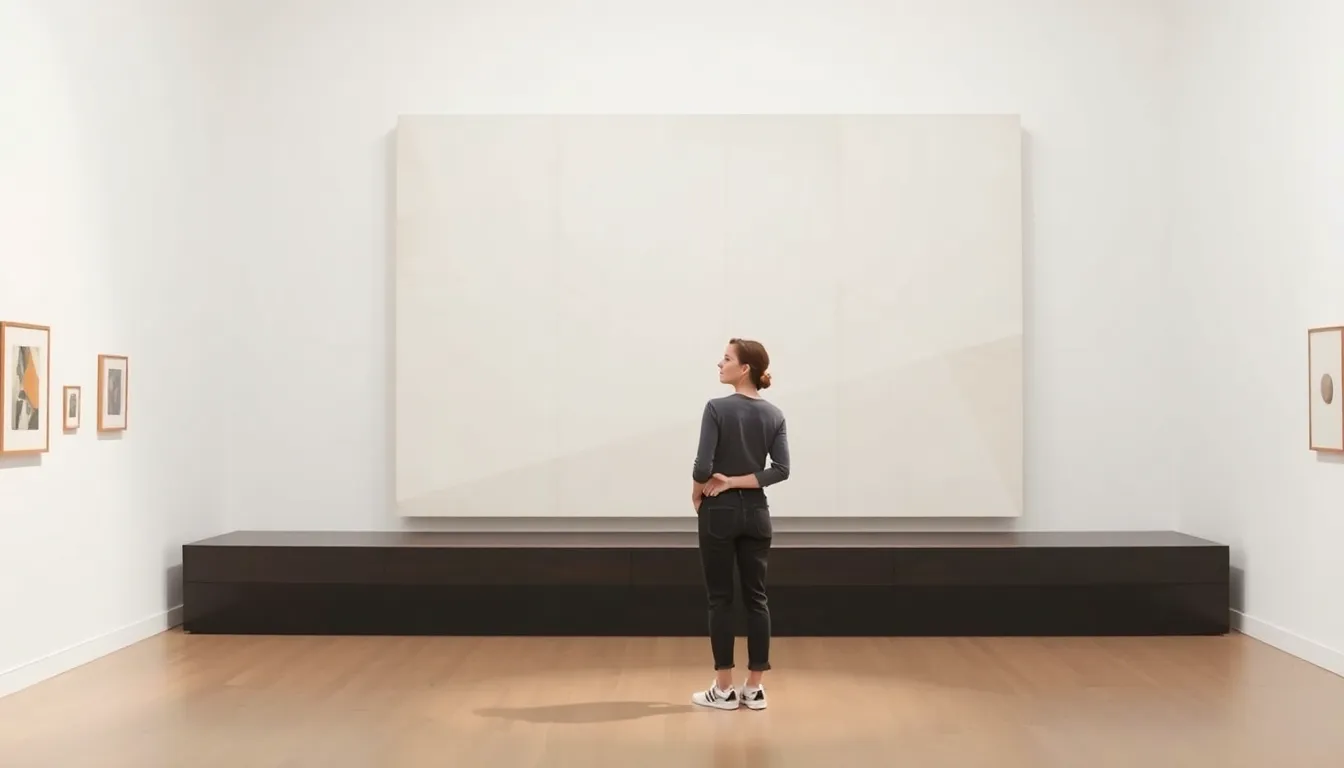In a world overflowing with visual noise, minimalist art stands out like a breath of fresh air—or a well-placed potted plant in a cluttered room. It strips away the excess and invites viewers to appreciate the beauty of simplicity. With just a few lines or blocks of color, minimalist artists challenge our perception, proving that less truly can be more.
Imagine walking into a gallery filled with vast white spaces and a single dot on the wall. It might seem absurd at first, but that dot? It’s a conversation starter, a thought provoker, and a reminder that sometimes, the simplest ideas carry the most weight. Minimalist art isn’t just about aesthetics; it’s a philosophy that encourages us to declutter our minds and lives. So, buckle up as we dive into the enchanting world of minimalist art and discover why it’s more than just a trend—it’s a lifestyle choice.
Table of Contents
ToggleUnderstanding Minimalist Art
Minimalist art emphasizes simplicity and clarity in visual expression. This art form thrives on the concept of reducing the elements to their essence, focusing on what is essential.
Definition and Characteristics
Minimalist art refers to a movement that emerged in the late 1950s, characterized by simplicity and geometric forms. Artists utilize limited colors, shapes, and materials, often embracing industrial or everyday objects. Each work encourages viewers to engage with the art in a contemplative manner. Textures and surfaces can play significant roles, highlighting the physicality of the medium. This art form often evokes emotional responses through stripped-down aesthetics rather than complex narratives.
Historical Context
Historical roots of minimalist art trace back to movements like Abstract Expressionism. In the 1960s, artists began to reject emotionalism, seeking objectivity in their work. Key figures such as Donald Judd and Agnes Martin challenged traditional artistic norms, promoting a minimalist philosophy. Art from this period often reflects social changes, responding to consumer culture and technological advancements. Museums and galleries began to embrace minimalism, recognizing its influence on contemporary art and design.
Key Artists in Minimalist Art

Minimalist art features several influential artists who shaped the movement’s principles. Two of the most prominent figures are Donald Judd and Agnes Martin.
Donald Judd
Donald Judd significantly impacted minimalist art through his emphasis on geometric forms and industrial materials. Known for his use of boxes, Judd’s work often includes production techniques from factories. He believed in presenting art without conventional frames, allowing viewers to interact with objects in space. Judd’s installations challenge perceptions of how art exists in the physical world, inviting contemplation of form, color, and materiality. His pieces often encourage engagement by creating a dialogue between the artwork and the environment. Judd’s philosophy advocates for art that maintains honesty and clarity, fundamentally changing the exhibition space.
Agnes Martin
Agnes Martin’s contributions to minimalist art emphasize tranquility and minimalism’s emotional depth. Renowned for her subtle line and grid patterns, she often employed soft, muted colors to evoke feelings of serenity. Martin’s work reflects her belief in simplicity as a path to profound beauty, focusing on the interplay of light and space. Each piece resonates with her personal experiences, infusing emotions into minimal forms. Intent on creating a meditative space, she aimed to inspire viewers to reflect on their inner world. Martin’s legacy lies in her ability to merge abstraction with spirituality, distinguishing her as a pivotal figure in minimalist art.
The Philosophy Behind Minimalist Art
Minimalist art transcends aesthetics. It embodies a philosophy rooted in simplicity and clarity, offering a refreshing perspective in a complex world.
Simplicity and Functionality
Simplicity defines minimalist art. Artists prioritize fundamental forms to enhance recognition, using geometric shapes and limited color palettes. Functionality emerges in the choice of materials, often referencing everyday objects to heighten the viewer’s awareness of their surroundings. Clarity exists in the absence of extraneous elements, allowing the essence of art to shine through. The focus on minimalism encourages viewers to question the necessity of complexity in design and life.
Emotional Response
Emotional depth resonates within minimalist art. Subtlety fosters profound connections, where simple lines or monochromatic surfaces evoke feelings of tranquility. Audiences react to the intentional space within works, which invites introspection and contemplation. Artists like Agnes Martin leverage these emotional responses, crafting pieces that inspire serenity and peace. The absence of clutter completes the emotional landscape, allowing viewers to engage more deeply with their thoughts and feelings.
Impact of Minimalist Art on Contemporary Culture
Minimalist art significantly shapes contemporary culture, influencing various aspects of life. Its core principle of simplicity permeates through design, architecture, and popular media.
Influence on Design and Architecture
Designers embrace minimalist aesthetics by focusing on clean lines and open spaces. This trend promotes functionality while eliminating unnecessary elements. Architects incorporate minimalist principles to create structures that resonate with their surroundings. Interiors reflect an emphasis on spaciousness, often using neutral palettes and natural materials. Brands frequently adopt these strategies to enhance user experience, making environments feel both approachable and calming. Minimalist design’s impact fosters an appreciation for essential beauty and intentional living.
Minimalism in Popular Media
Film and photography often reflect minimalist themes through their visual narratives. Directors use sparse settings to evoke emotion and foster contemplation. In literature, minimalist writing styles prioritize clarity, focusing on essential elements without superfluous detail. This trend resonates with audiences seeking authenticity and depth in storytelling. Social media platforms also showcase minimalist aesthetics, with influencers highlighting the beauty of simplicity in their content. Overall, minimalist art’s reach in popular media encourages a culture that values mindfulness and simplicity in everyday life.
Minimalist art serves as a powerful reminder of the strength found in simplicity. Its ability to provoke thought and inspire introspection underscores the importance of clarity in a chaotic world. By stripping away excess and focusing on essential elements, minimalist artists invite viewers to engage with their surroundings in a more meaningful way.
This artistic movement transcends traditional boundaries, influencing various aspects of contemporary culture, from design to architecture and beyond. As society continues to navigate complexity, the principles of minimalist art encourage a return to mindfulness and intentional living, making it a relevant and impactful philosophy for today’s world. Embracing minimalism can lead to a deeper appreciation for the beauty that lies in simplicity.



